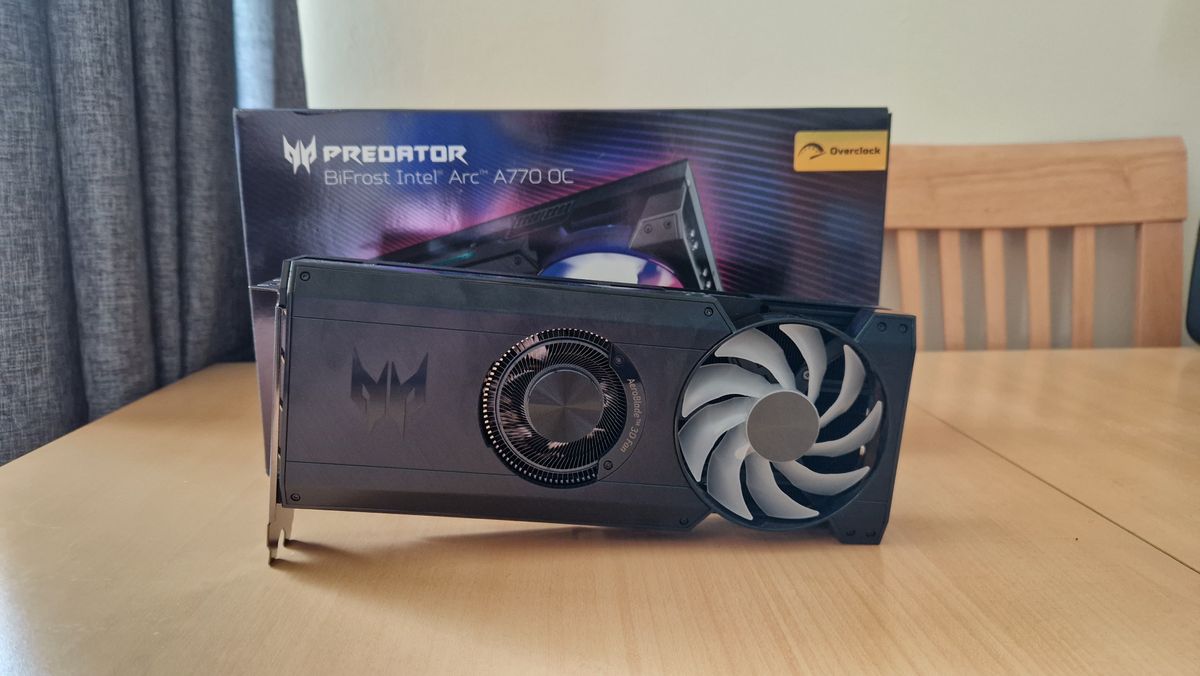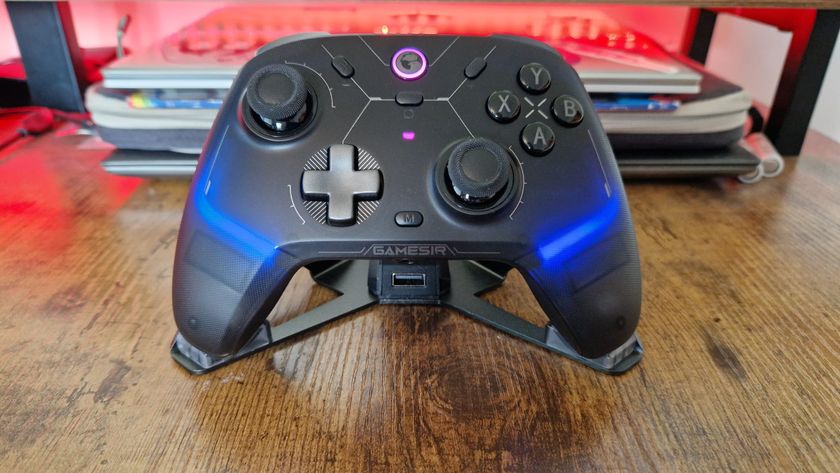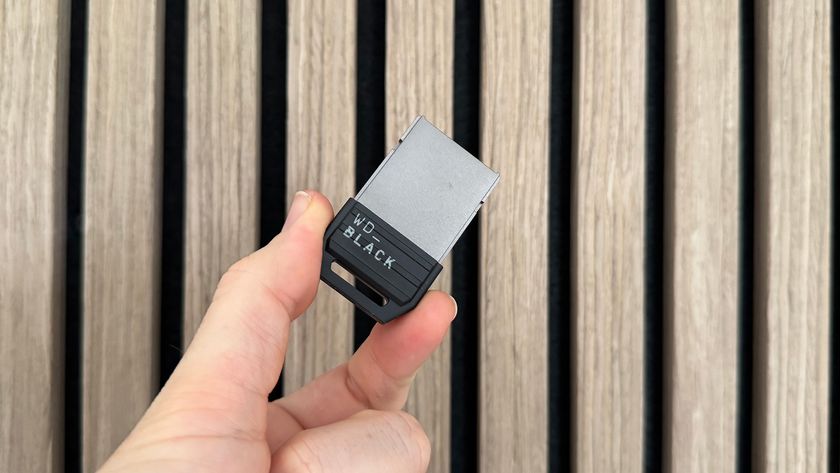12DOVE Verdict
Acer's Intel Arc A770 is a bona fide contender in the GPU arena that deserves to be taken seriously. It offers 16GB of VRAM, ongoing support, and excellent all-round gaming performance in a reasonably priced package. If you hate the prices of modern GPUs and you don't care about DLSS and Ray Tracing, an Arc A770 lets you vote with your wallet without compromising on performance.
Pros
- +
16GB of VRAM to play with
- +
Very playable 4K frame rates
- +
It keeps getting better
- +
Cheaper than 16GB rivals
Cons
- -
The Acer variant of the A770 doesn't come cheap
- -
Battlemage is coming
- -
Ray tracing isn't great
Why you can trust 12DOVE
The Acer Predator BiFrost Intel Arc A770 OC has become something of a flagship for Intel of late. With the Limited Edition A770 finally being retired, Acer's variant is one of the last few 16GB Arc A770s left standing.
If you read any of my reviews of the best graphics cards back-to-back, you'll probably get sick of me yammering on about their prices these days. Since 2020, graphics card prices have been in a state of disrepair. Nvidia has had a monopoly, and although AMD has undercut to stay competitive, it's arguably still enjoying higher prices than it should. Following cries of desperation from gamers wanting something resembling affordable, Intel entered the gladiatorial arena wielding this, the Arc A770.
Sadly, the Intel Arc graphics cards have struggled to be taken seriously since their launch in October 2022. Many folks in the gaming PC world have mocked and jeered as these boards find their feet, despite their more affordable price tags. But Intel hasn't shied away from that adversity. It's stood by its little side project, supported it with driver updates and game optimizations, and now waits in the wings with a second generation that, if rumors are to be believed, should be taken very seriously.
If there's one thing reviewing this (admittedly pricier) $399 / £299 Acer model of the A770 has taught me, it's that Intel might just get the last laugh.
Design
I have to say, I'm a big fan of the Acer Predator BiFrost design for this Arc A770. It has a glossy finish on some of its panels with a more Arc-style matte texture on the others. Two beautiful RGB fans stand out in distinct ways, even through my mesh Corsair Airflow 2000D chassis. The Acer branding on both sides is overt, but in my eyes doesn't overstate itself. In terms of gunning for that "best looking GPU" spot, this is certainly up there with the PNY RTX 4070 Ti I reviewed.
A wee positive I do want to note is that in the box you get a small ADATA USB stick that has a version of the Intel Arc A770's drivers on it. The drivers themselves will likely be out of date by the time you get yours, but this little freebie has 32GB of storage space on it in a super convenient size for taking on the go or attaching to a keyring. It's a serious finger smudge magnet due to its glossy finish, but I do love its inclusion in the box.


Elsewhere in the design department, we have four connectivity ports. These are three DisplayPort 2.0s and one HDMI 2.1. This is a dual-slot GPU that weighs approx 1.13Kg, so it isn't the lightest board out there. While I wouldn't say it necessarily needs a support bracket, looking into a cheap and cheerful option is never ever a bad idea. In my case the GPU mounts vertically, so I haven't had to test this out, but to figure out if you need a GPU support bracket, we put together a handy guide.
Dimensions are 26.67 x 11.68cm (L x H), so it is on the longer side, and more comparable to triple fan cards. I found during my PC build that it was more maneuverable than bigger GPUs typically are, and size hasn't been an issue fitting it inside an ITX (smaller form factor) case. I doubt it would struggle to fit inside any of the best PC cases.
As expected, the Arc A770 connects via PCIe 4.0, and connects to a PSU via two 8-pin cables - beefy.
Specs and Features
| Price (MSRP) | $299 / £299 |
| GPU | DG2-512 |
| Shading units | 4,096 |
| Tensor Cores | 512 |
| RT Cores | 32 |
| Base Clock | 2200MHz |
| Boost Clock | 2400MHz |
| VRAM | 16GB GDDR6 |
So, the Intel Arc A770 features 16GB of VRAM, frequently making this the cheapest 16GB GPU on the market. It has a GPU clock of 2.20GHz, a power supply wattage of 650W, and a max resolution of 7680 x 4320 at 60Hz, so it will handle general PC usage on one of the best gaming monitors with ease. For peace of mind, it's backed by a standard 2-year warranty courtesy of Acer.
Of course, there's also an "OC" (overclocked) at the end of this GPU's mouthful of a name, and that's because it features a 2.4GHz boost clock. Elsewhere, the card sports a memory bandwidth of 256bit, with an 18Gbps memory speed. You'll also have access to AI-enhanced upscaling with Xe Super Sampling in games that support it, but more on how this performed in Cyberpunk 2077 shortly.
To address the elephant in the room some people might be glaring at, the Arc A770 supports DirectX 12 Ultimate and Ray Tracing, and yes, although older versions of DirectX proved problematic for Intel's Arc cards at launch, this is something the manufacturer of the best CPUs for gaming has remedied. As you'll see when we get onto performance, that isn't an issue I've encountered - despite no lack of trying.
That 92mm FrostBlade 2.0 fan I mentioned earlier is customizable, by the way. Acer's Predator BiFrost app helps to personalize the lighting, which is a nice touch, although depending on your setup, it might just mean one more app trying to rule your PC's roost.
That airflow cooling is backed by a 5th Gen AeroBlade 3D fan, the likes of which you'll see on other Intel Arc boards. Vapor Chamber Streamlining Airflow design helps to spread cool air through the chipset, although arguably this could be better, as I've noticed the A770 can run a little warm on occasion.
Performance
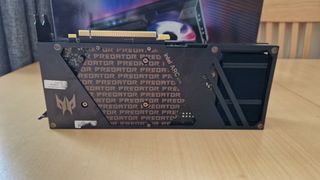
I've probably done more extensive testing with the Acer Predator BiFrost Intel Arc A770 OC than I have for any other graphics card review. This is, first and foremost, to test out how the A770 works in as wide a variety of games as possible now that we're coming up on a year after release. But on a more curious note, I ended up testing more because I kept getting pleasantly surprised by how it performed in game after game.
Naturally, I began with our new standard GPU benchmarking games. These are titles that have all the technical demands to make modern components fear for their lives, and in my book, they all paint a similar picture. Played at 4K with maxed-out settings, the Arc isn't the be-all and end-all, particularly in in-game benchmark tests. On the other hand, with settings turned down a few notches during gameplay, I got very playable 4K frame rates that were on either side of the 60fps mark.
In wider testing, I tried to play a mix of DirectX11 and even DirectX9 games, since I knew these were a contentious area for the Arc series until more recent patches.

With this being a 16GB beast, I wasn't really concerned with 1080p performance. I decided to exclusively test at 1440p and 4K, and the results at those resolutions should tell you everything you need to know about full HD. Given this is very much a value option in the GPU market, I'd say that 16GB of headroom for higher resolutions makes this an excellent card for futureproofing. If you're still married to 1080p and last-gen's best RAM for gaming (which is totally understandable given how expensive things are) this GPU can be a reasonably priced upgrade that will still be there for you when you do graduate to newer specs.
Overall in gaming performance, I'm really pleased with the A770's price-to-performance. Pound for pound, it's up there with my favorite GPUs on the market. Here's how it got on in those demanding benchmarking games:
| Ultra/highest settings | 1440p | 1440p with ray tracing | 4K | 4K with ray tracing |
| Hitman 3 | 88fps | 35fps | 52fps | 22fps |
| Returnal | 57fps | 42fps | 33fps | 22fps |
| Total War: Warhammer 3 | 45fps | NA | 25fps | NA |
| Cyberpunk 2077 | 55fps | 19fps | 29fps | 9fps |
When you look at these testing numbers raw, they really don't seem that impressive. If you remember its price compared to other 4K 16GB cards, however, you start to see more value. Moreover, and as I mentioned, during gameplay things were much smoother.
Returnal got comfortably over the 60fps mark at 4K when I turned ray tracing off and dialed some settings down. Outside of Hitman 3's Dartmoor benchmark, I was walking around as Agent 47 in multiple contracts at 4K60, and around 90fps at 1440p. In Cyberpunk at 4K with mid settings and no ray tracing, the frame rate got up to 43fps - I have no doubt 4K 60 is possible here if you really play around in settings. One caveat I'd definitely add is that you should steer clear of Intel's Xe super sampling in Cyberpunk - for me it caused some bizarre visual glitches that meant light sources spawned in as little glittery stars, and most scenes were draped in black void.
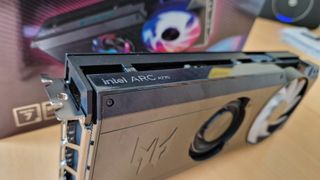
If I can stop justifying for a moment, those benchmark scores are still impressive. In Cyberpunk, the Acer Predator BiFrost outperformed the RTX 4060's non-DLSS 4K and 1440p performance when ray tracing wasn't part of the equation. In Hitman 3, the same two cards pulled identical numbers at 4K and 1440p. In my books, that's a good enough reason to recommend this card, and really shows the improvements Intel has made.
Admittedly, ray tracing performance was an Achilles heel for the A770 - although, if you're looking to buy a lower-priced GPU not made by Nvidia, I doubt that's going to be a thorn in your paw. While Cyberpunk's 4K ray tracing performance is pretty poor, do remember that game is notoriously optimized for Nvidia cards that use DLSS and those top-drawer RT-Cores.
3DMark benchmarks
Time Spy
Overall: 13, 069
Graphics Score: 12,760
CPU Score: 15,149
Fire Strike
Overall: 28,544
Graphics Score: 32,902
Physics Score: 34,148
Combined Score: 12,747
But what about those older titles that struggled in the Intel Arc's opening months? DirectX12 is the most commonly used API (application programming interface - essentially a software developed by Microsoft to organize shaders, samplers, and otherwise run graphics in a certain way) in games today, but older versions are still common, especially in games that have been supported continuously since launch. Older game performance might seem silly to assess in a modern GPU review, but it's important because hell - we all have backlogs to get through, right?
Besides some initial launcher wobbles from Apex Legends and a few minor opening stutters when playing Dishonored, performance in older games was super stable. As you'll see below. Alongside these older games, I tested out some of my favorite titles and the ones I've been playing most recently on PC.
| 4K, max settings | FPS | API/Engine | Initial Release |
|---|---|---|---|
| HUNT: Showdown | 70fps | DirectX 11 | 2018 |
| Apex Legends | 96fps | DirectX 11 | 2019 |
| Dishonored Definitive Edition | 110fps | DirectX 9 | 2015 |
| Cities Skylines | 80fps | DirectX 9 | 2015 |
| Oblivion | 120fps | DirectX 9 | 2006 |
| Just Cause 2 | 110fps | Direct3D | 2010 |
| Timberborn | 120fps | DirectX 11 | 2021 |
All of these numbers paint a picture of a GPU that will give you very respectable frame rates in modern and older games. Yes, you could get more out of an Nvidia card using DLSS, but in the 16GB arena, and more importantly, at this price? There isn't much that can offer this kind of value.
Personally, this is all the GPU I really need. But what doesn't it do so well? A major drawback to Acer's Intel Arc A770 is that this is supposed to be a true value option. At the near $400/£300 mark, Acer is pricing it closer to the RTX 4060, and far too close to the AMD Radeon RX 7600. That said, this is Acer's first-ever GPU, and you can find it on offer pretty frequently.
The only other reason I wouldn't recommend this card is that it does seem as though Battlemage, the next generation of Intel GPUs, is arriving soon. There's probably a mistake or two that's been ironed out, better value to be had, and more modern architecture at play in this upcoming batch. That isn't to say this won't be supported, however - new Arc patches get dropped frequently, and just a few months ago, this card, in particular, got a quoted 60% performance boost across the board. To me, that signals that ongoing support will be there for a while yet.
Should you buy the Acer Predator BiFrost Intel Arc A770 OC?
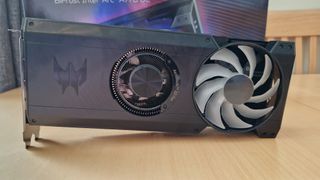
I recently built a new gaming PC, and when assembling the parts, I had a choice between an Nvidia 40 series mid-ranger that shall remain nameless and Acer's Intel Arc A770. I chose this one, mainly because I wanted that 16GB of VRAM for higher resolution headroom, and because I don't much care for ray tracing if I'm honest. After putting this A770 through the wringer, that decision isn't something I'd go back on.
It's not very common these days to find a GPU that feels like it offers true value. Don't get me wrong, Acer's prices sort of miss the point on that front, but if you can get this on sale, I wholeheartedly recommend that you do.
Versus the RTX 4060, or 4060 Ti, it really depends. Is DLSS really that important?
Don't get me wrong, it is great technology, but I'd rather have a GPU that has organic power and VRAM headroom over something that's reliant on AI frame generation that isn't supported by every game. Put simply, I don't know how I feel about a piece of hardware's biggest selling point being fairly proprietary software, even if it is widely adopted.
Nvidia's 40 series cards feel to me as though they're intentionally hamstrung so that better performance and value can be "unleashed" for more money later down the road. On the flip side, Intel's slew of updates and improvements feel transparent and like they're released in good faith.
In my eyes, Intel's GPUs deserve more respect than they get. Whether it's for better value, for continued support, or for a shake-up to a stagnant GPU market. More buying options are never a bad thing. Overall, the Intel Arc A770 is a contender to be taken seriously, and it points to a very interesting market in the coming years.
How we tested the Acer Predator BiFrost Intel Arc A770 OC
I've put the Acer Predator BiFrost Intel Arc A770 OC through the wringer over the past month or so, using it in my own personal PC that I use for work, gaming, and content creation. For this review, I playtested a slew of modern and older games to see how this graphics card worked as a component in modern gaming PCs.
The build I tested this GPU in comprises a 13th Gen Intel Core i5-13600K, Sabrent Rocket DDR5 RAM, Seagate Firecuda 530 2TB SSD, and an ASUS ROG Strix Z790-i motherboard.
For the most part, I used in-game benchmarks and switched on and off various settings to track scores and test different elements. Naturally, my experience was compared to other GPUs I've used and reviewed, but mainly the more affordable mid-rangers this Intel Arc A770 is competing with. Where in-game benchmarks weren't available, I used average frame rates.
If you'd like to read more about the ways we test the latest gaming tech here at 12DOVE, take a look at our hardware policy.
For more on gaming PCs and their components, check out the best Alienware gaming PCs, the best Steam Deck Docks, and the best gaming mouse.
One of my earliest memories is playing SuperMario64 and wondering why the controller I held had three grips, but I only had two hands. Ever since I've been in love with video games and their technology. After graduating from Edinburgh Napier University with a degree in Journalism, I contributed to the Scottish Games Network and completed an Editorial Internship at Expert Reviews. Over the last decade, I’ve been managing my own YouTube channel about my love of games too. These days, I'm one of the resident hardware nerds at 12DOVE, and I take the lead on our coverage of gaming PCs, VR, controllers, gaming chairs, and content creation gear. Now, I better stop myself here before I get talking about my favourite games like HUNT: Showdown, Dishonored, and Towerfall Ascension. Location: UK Remote

Fire Force season 3 release schedule – when is episode 1 on Crunchyroll and Netflix?

Devil May Cry ending explained: Who is King Mundus? What does it mean for season 2?

Devil May Cry review: "Netflix's anime adaptation is dated and clunky, but does capture some of the anarchic spirit of the original games"
